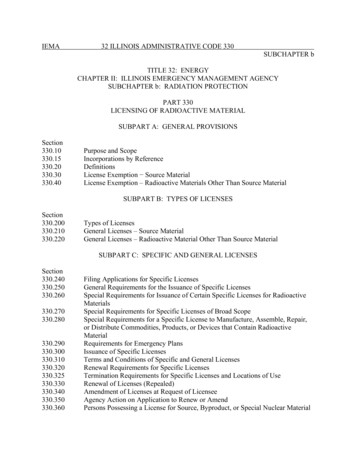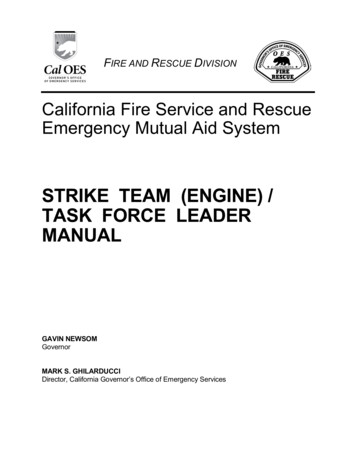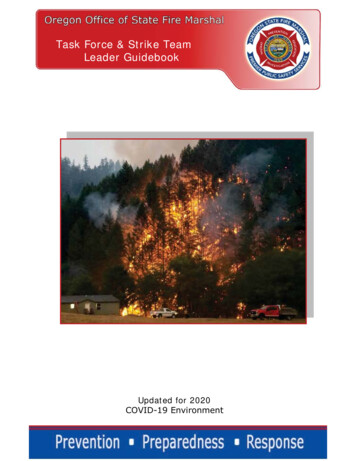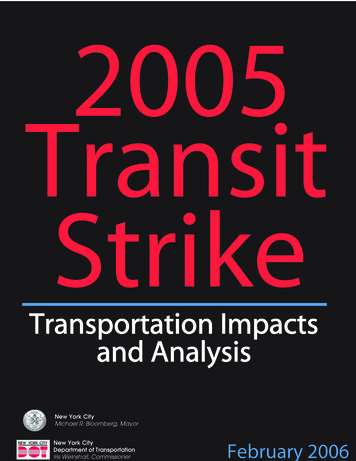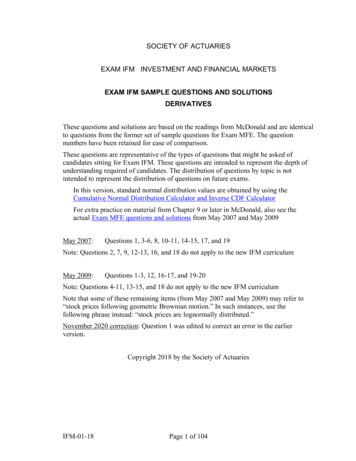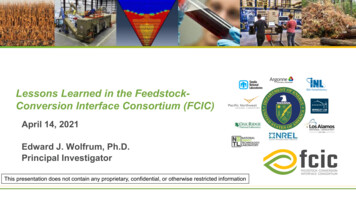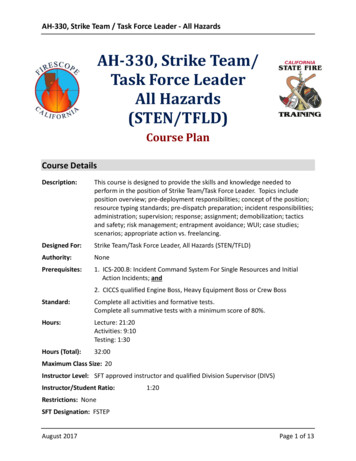
Transcription
AH-330, Strike Team / Task Force Leader - All HazardsAH-330, Strike Team/Task Force LeaderAll Hazards(STEN/TFLD)Course PlanCourse DetailsDescription:This course is designed to provide the skills and knowledge needed toperform in the position of Strike Team/Task Force Leader. Topics includeposition overview; pre-deployment responsibilities; concept of the position;resource typing standards; pre-dispatch preparation; incident responsibilities;administration; supervision; response; assignment; demobilization; tacticsand safety; risk management; entrapment avoidance; WUI; case studies;scenarios; appropriate action vs. freelancing.Designed For:Strike Team/Task Force Leader, All Hazards (STEN/TFLD)Authority:NonePrerequisites:1. ICS-200.B: Incident Command System For Single Resources and InitialAction Incidents; and2. CICCS qualified Engine Boss, Heavy Equipment Boss or Crew BossStandard:Complete all activities and formative tests.Complete all summative tests with a minimum score of 80%.Hours:Lecture: 21:20Activities: 9:10Testing: 1:30Hours (Total):32:00Maximum Class Size: 20Instructor Level: SFT approved instructor and qualified Division Supervisor (DIVS)Instructor/Student Ratio:1:20Restrictions: NoneSFT Designation: FSTEPAugust 2017Page 1 of 13
AH-330, Strike Team / Task Force Leader - All HazardsRequired ResourcesInstructor ResourcesTo teach this course, instructors need: FIRESCOPE AH-330 Strike Team/Task Force Leader Instructor Manualo http://osfm.fire.ca.gov/training/SFTCurriculum FIRESCOPE AH-330 PowerPoint Presentationo http://osfm.fire.ca.gov/training/SFTCurriculum FIRESCOPE ICS-420-1, Field Operations Guide (current edition)o http://firescope.org/ NWCG PMS 461 Incident Response Pocket Guide (current edition)o https://www.nwcg.gov/Student ResourcesTo participate in this course, students need (if assigned by instructors): FIRESCOPE AH-330 Strike Team/Task Force Leader Student Manualo http://osfm.fire.ca.gov/training/SFTCurriculum FIRESCOPE ICS-420-1, Field Operations Guide (current edition)o http://firescope.org/ NWCG PMS 461 Incident Response Pocket Guide (current edition)o https://www.nwcg.gov/Facilities, Equipment, and PersonnelThe following facilities, equipment, or personnel are required to deliver this course:Facilities Standard classroom set up for up to 30 studentsProjector for audio/visual presentationsInternet accessAugust 2017Page 2 of 13
AH-330, Strike Team / Task Force Leader - All HazardsUnit 1: IntroductionTopic 1-1: Orientation and AdministrationTerminal Learning ObjectiveAt the end of this topic, a student will be able to identify facility and classroom requirementsand identify course objectives, events, requirements, assignments, activities, resources,evaluation methods, and participation requirements in the course syllabus.Enabling Learning Objectives1. Identify facility requirements Restroom locations Food locations Smoking locations Emergency procedures2. Identify classroom requirements Start and end times Breaks Electronic device policies Special needs and accommodations Other requirements as applicable3. Review course syllabus Course objectives Calendar of events Course requirements Student evaluation process Assignments Activities Required student resources Class participation requirementsDiscussion Questions1. What is a formative test? What is a summative test?Activities1. To be determined by the instructor.2. Activity: Have students’ pair up with someone they do not know. For five minutes,interview each other (2 ½ minutes each). Be prepared to introduce the other student tothe class. Allow 30 minutes.Topic 1-2: Course IntroductionTerminal Learning ObjectiveAt the end of this topic, a student, will be able to describe the expectations of this course,the use of job aids and the Position Task Book as well as the CICCS requirements for thisposition.August 2017Page 3 of 13
AH-330, Strike Team / Task Force Leader - All HazardsEnabling Learning Objectives1. Identify the overall course objectives2. Identify instructors3. Identify students4. Identify the student profile sheet5. Identify student expectations6. Describe how to navigate the electronic student manualDiscussion Questions1. Refer to instructors manualActivities1. There are no activities in Topic 1-1Instructor Note1. Instructor will use the written curriculum for this topicUnit 2: Pre-deployment ResponsibilitiesTopic 2-1: Concept of a Strike Team/Task Force LeaderTerminal Learning ObjectiveAt the end of this topic, a student, given basic responsibilities of the Strike Team/Task ForceLeader (ST/TFL), will be able to define the differences between a Strike Team and a TaskForce, so that Strike Team/Task Force Leaders will maximize the use of resources, reducesthe span-of-control and simplifies communications.Enabling Learning Objectives1. Define a Strike Team2. Define a Task Force3. Describe the basic responsibilities of a ST/TFL4. Describe the ST/TFL concept and where the leader fits into the Incident CommandSystem5. Differentiate between the types of Strike TeamsDiscussion Questions1. Refer to instructors manualActivities1. There are no activities in topic 2-1Instructor Note1. Instructor will use the written curriculum for this topicTopic 2-2: Resource Typing StandardsTerminal Learning ObjectiveAt the end of this topic, a student, given typing of resources with minimum staffing, will beable to identify the qualification requirements for ST/TF personnel, so that ST/TF are formedand designated with the all hazard incident command structure.August 2017Page 4 of 13
AH-330, Strike Team / Task Force Leader - All HazardsEnabling Learning Objectives1. Determine the typing of Engine, Crew and Dozer Strike Teams2. Describe minimum personnel staffing3. Identify qualifications/requirements for ST/TF personnel4. Describe how Strike Teams are formed and designatedDiscussion Questions1. Refer to instructors manualActivities1. There are no activities in topic 2-2Instructor Notes1. Instructor will use the written curriculum for this topicTopic 2-3: Pre-Dispatch PreparationTerminal Learning ObjectiveAt the end of this topic, a student, given elements that a ST/TFL prepares for an assignmentbefore an incident occurs, will be able to build your ST/TFL kit and personal “kit”, describethe tools you will need to assemble, brief and coordinate your resources while traveling to,during and returning from an incident, so that the safety, coordination and needs of allpersonnel and equipment on your ST/TF are provided.Enabling Learning Objectives1. Identify what to include in your ST/TFL kit2. Determine what items to carry in your personal kit3. Determine that resources are ready with adequate supplies for self-sufficiency out oftheir area4. Describe and participate in readiness exercises designed to evaluate your mobilizationcapabilitiesDiscussion Questions1. Refer to instructors manualActivities1. There are no activities in topicInstructor Notes1. Instructor will use the written curriculum for this topicUnit 3: Incident ResponsibilitiesTopic 3-1: AdministrationTerminal Learning ObjectiveAt the end of this topic, a student, given administrative duties as a ST/TFL, will be able tomanage personnel actions, significant events and equipment issues, so that understandingof agreements are maintained and the duties are managed with maximum coordination,notification and documentation.August 2017Page 5 of 13
AH-330, Strike Team / Task Force Leader - All HazardsEnabling Learning Objectives1. Describe ST/TFL’s administrative responsibilities regarding personnel actions that mayneed recognition or modification2. Describe the scope of a ST/TFL’s responsibility if a significant event such as a burn-over,injury or fatality should occur involving the ST/TF3. Describe a ST/TFL’s administrative function regarding equipment and property issues4. Describe the types of agreements a ST/TFL may be operating under on any givenincidentDiscussion Questions1. Refer to instructors manualActivities1. There are no activities in this topic 3-1Instructor Notes1. Instructor will use the written curriculum for this topicTopic 3-2: SupervisionTerminal Learning ObjectiveAt the end of this topic, a student, given leadership principles and elements ofperformance based accountability, will be able to manage and lead the resources of aST/TF, so that the assignment will complete all operational goals with the elements ofmanagement and supervision while keeping personnel on track.Enabling Learning Objectives1. Describe an understanding of leadership principles2. Describe an understanding of performance based accountability3. Describe utilization of the Operational Leadership Guide as it relates to emergencyresponse situations4. Describe the three primary leadership styles, when each style is appropriate and whichstyle you tend to exhibit most oftenDiscussion Questions1. Refer to instructors manualActivities1. There are no activities in topic 3-2Instructor Notes1. Instructor will use the written curriculum for this topicTopic 3-3: Strike Team/Task Force ResponseTerminal Learning ObjectiveAt the end of this topic, a student, given information gathering process, rendezvousresponsibilities, travel procedures, and logistical needs and issues, will be able to performthe proper steps to assemble and brief the ST/TF on the assignment, operationalprocedures, expectations, information on the equipment and personnel, so thatguidelines for assignment, safe travel routes and checking in are performed on all hazardAugust 2017Page 6 of 13
AH-330, Strike Team / Task Force Leader - All Hazardsincidents.Enabling Learning Objectives1. Describe the information gathering process and the sources of needed information2. Describe the ST/TFL’s rendezvous responsibilities for both pre-arrival and at scene formup3. Describe elements to convey safe and appropriate travel procedures4. Describe measures to address any enroute logistical needs and issues5. Describe where to check in at an incident and the check in processDiscussion Questions1. Refer to instructors manualActivities1. There is one (1) activity in topic 3-3Instructor Notes1. Instructor will use the written curriculum for this topicTopic 3-4: Assignment/StatusTerminal Learning ObjectiveAt the end of this topic, a student, given ST/TFL responsibilities for the multiple statuslevels of assignment, will be able to manage assigned resources, so that Strike Team/TaskForce resources are managed within incident guidelines matching assignments whileassigned to an incident.Enabling Learning Objectives1. Describe the primary responsibilities of the ST/TFL while on available status2. Describe the ST/TFL responsibilities while on assigned status3. Describe the ST/TFL responsibilities while on out-of-service statusDiscussion Questions1. Refer to instructors manualActivities1. There are three (3) activities in topic 3-4Instructor Notes1. Instructor will use the written curriculum for this topicTopic 3-5: DemobilizationTerminal Learning ObjectiveAt the end of this topic, a student, given demobilization procedures and administrativeduties, will be able to properly demob, so that maximum safety and orderlydemobilization is completed with the resources of the ST/TF for efficient return to homeassignment.Enabling Learning Objectives1. Describe the process to ensure that assigned resources are ready for demobilization2. Describe the administrative duties which must be completed prior to demobilizationAugust 2017Page 7 of 13
AH-330, Strike Team / Task Force Leader - All Hazards3. Describe how the demobilization process applies to a ST/TF as opposed to a singleresource leaderDiscussion Questions1. Refer to instructors manualActivities1. There are no activities in topic 3-5Instructor Notes1. Instructor will use the written curriculum for this topicTopic 3-6: An Operational Period as a ST/TFLTerminal Learning ObjectiveAt the end of this topic, a student, given ST/TFL’s role, elements of the on going incidentwith operational periods, briefing responsibilities, and responsibilities for closing of theoperational period, will be able establish a snapshot in the “day in the life of a ST/TFleader”, so that elements and procedures are administered and managed on the allhazard incident.Enabling Learning Objectives1. Describe the ST/TFL’s role in initial response2. Describe the ST/TFL role in an ongoing incident including a formal operational periodbriefing and utilization of an IAP3. Describe the process of briefing assigned resources4. Describe the debriefing process and with whom at the end of an operational period5. Describe some indicators at an incident that the ST/TFL may need to recognizeDiscussion Questions1. Refer to instructors manualActivities1. There are no activities in topic 3-6Instructor Notes2. Instructor will use the written curriculum for this topicUnit 4: Tactics and SafetyTopic 4-1: Risk ManagementTerminal Learning ObjectiveAt the end of this topic, a student, given concepts of risk management, risk assessment, andrisk control, will be able to manage risk and the risk control elements, so that risk ismanaged with calculated and pre-determined tools with proper risk refusal.Enabling Learning Objectives1. Describe the concept of Risk Management and the Risk Management Process2. Determine risk assessment and its applications3. Describe the concepts of risk controlAugust 2017Page 8 of 13
AH-330, Strike Team / Task Force Leader - All Hazards4. Determine requirements on how to properly refuse riskDiscussion Questions1. Refer to instructors manualActivities1. There are two (2) activities in topic 4-1Instructor Notes1. Instructor will use the written curriculum for this topicTopic 4-2: Entrapment AvoidanceTerminal Learning ObjectiveAt the end of this topic, a student, given principles of LCES, protocols for negotiating anunsafe assignment, valid trigger points, fireline conditions, will be able to determineescape routes and safety zones when engaging a fire, so that human factors thatcontribute to fireline decision errors are managed with fireline conditions and utilizationof required safety zones for maximum personnel safety considerations.Enabling Learning Objectives1. Describe the role that LCES has in the Risk Management Process2. Describe a protocol for negotiating an unsafe assignment3. Define trigger point and levels of engagement4. Identify a set of fireline conditions5. Determine valid trigger points6. Describe a procedure for recognizing escape routes and safety zones when engaging afire7. Identify a set of fireline conditions8. Determine estimate minimum safety zone size9. Describe human factors that contribute to fireline decision errors10. Determine the appropriate level of engagement as conditions change with a givenscenarioDiscussion Questions1. Refer to instructors manualActivities1. There is one (1) activity in topic 4-3Instructor Notes1. Instructor will use the written curriculum for this topicTopic 4-3: Tactical Considerations – Wildland/Urban InterfaceTerminal Learning ObjectiveAt the end of this topic, a student, given leaders intent, concepts of wildland perimetercontrol, wildland structure environment, elements of area orientation, and situation andfire behavior forecasting, will be able to determine tactical maneuvers and tacticalactions, so that an appropriate tactical engagement process is determine utilizingFIRESCOPE WUI placarding system.August 2017Page 9 of 13
AH-330, Strike Team / Task Force Leader - All HazardsEnabling Learning Objectives1. Describe leaders intent2. Determine the concept of wildland perimeter control and the wildland structureenvironment3. Describe the importance of orienting yourself to the area, situation and fire behaviorforecasting4. Describe structure protection size up, triage guidelines, protection guidelines, protectionstrategies and protection tactics5. Describe tactical maneuver and tactical actions6. Describe the tactical engagement process – PACE7. Determine the levels of engagement – DRAW-D8. Determine how to use the FIRESCOPE WUI placarding systemDiscussion Questions1. Refer to instructors manualActivities1. There is one (1) activity in topic 4-4Instructor Notes1. Instructor will use the written curriculum for this topicTopic 4-4: Case StudiesTerminal Learning ObjectiveAt the end of this topic, a student, given all hazard incidents, will be able to determineand establish incident objectives, establish briefing elements, and provide feedbackaction item feedback for passover assignments on case studies, so that a relief transitionassignment can carry the objectives of an incident action plan during the next operationalperiod responding to an appropriate question and answer period.Enabling Learning Objectives1. Describe what was planned, what actually happened, why did it happen, and what canwe do next time: Case Study #1: Cedar Fire Fatality Case Study #2: Hwy 38 MCI Case Study #3: San Bernardino Active Shooter Incident Case Study #4: NAPA Earthquake Case Study #5: Instructor is to determine a case study or two from the previousincident year to deliver to students to maintain recencyDiscussion Questions1. Refer to instructors manualActivities1. There are five (5) activities in topic 4-5Instructor Notes1. Instructor will use the written curriculum for this topicAugust 2017Page 10 of 13
AH-330, Strike Team / Task Force Leader - All Hazards2. Instructor is to determine a case study or two from the previous incident year to deliverto students to maintain recencyTopic 4-5: ScenariosTerminal Learning ObjectiveAt the end of this topic, a student, given incident situations, will be able to identify anddescribe typical situations that may be encountered as a ST/TFL, so that a predeterminedsystematic problem analysis is completed and can be documented or reported for standardoutcomes.Enabling Learning Objectives1. Identify and determine incident elements that need attention for the 21 scenarios thateach slide shows2. Determine elements and decisions as to what the resolve is to the problem3. Describe suggested outcomesDiscussion Questions1. Refer to instructors manualActivities1. There is one (1) activity, all inclusive, in topic 4-6Instructor Notes1. Instructor will use the written curriculum for this topicTopic 4-6: Appropriate Action vs. FreelancingTerminal Learning ObjectiveAt the end of this topic, a student, given situations and scenarios, will be able to determinea course of action, determine unintended consequences, and identify potential freelancingdecisions, so that the appropriate actions are determined to be directly in support of the allhazard incident action plan avoiding freelancing decisions.Enabling Learning Objectives1. Determine situations that include appropriate action that may be applicable2. Determine the considerations when taking appropriate action3. Describe the contraindications of taking appropriate action4. Describe the consequences of freelancingDiscussion Questions1. Refer to instructors manualActivities1. There are no activities in topic 4-6Instructor Notes1. Instructor will use the written curriculum for this topicAugust 2017Page 11 of 13
AH-330, Strike Team / Task Force Leader - All HazardsTime TableLectureTimeSegmentUnit 1: IntroductionTopic 1-1: Course IntroductionLectureUnit 1 TotalsUnit 2: Pre-Deployment ResponsibilitiesTopic 2-1: Concept of a ST/TFLLectureTopic 2-2: Resource Typing StandardsLectureTopic 2-3: Pre-Dispatch PreparationLectureUnit 2 TotalsUnit 3: Incident ResponsibilitiesTopic 3-1: AdministrationLectureTopic 3-2: SupervisionLectureTopic 3-3: Strike Team/Task Force ResponseLectureActivity: ST Assembly BriefingTopic 3-4: Assignment/StatusLectureActivity: King IAPActivity: Division Breakout VideoActivity: Assignment BriefingTopic 3-5: DemobilizationLectureTopic 3-6: An Operational Period as a ST/TFLLectureUnit 4: Tactics and SafetyTopic 4-1: Risk ManagementLectureActivity: Risk AssessmentAugust 2017Unit 3 Totals 7:101:301:30ActivityTimeTotal e 12 of 13
AH-330, Strike Team / Task Force Leader - All HazardsActivity: Gavalin IncidentTopic 4-2: Entrapment AvoidanceLectureActivity: High Meadows Case StudyTopic 4-3: Tactical Considerations - WUILectureActivity: WUI PlacardTopic 4-4: Tactical Considerations Case StudiesLectureActivity 4-4: To be determined0:301:300:301:400:200:00Topic 4-5: ScenariosLectureActivity: 21 slide scenariosTopic 4-6: Appropriate Action vs. FreelancingLectureLocal/Agency Specific IssuesLectureFinal Scenario ExerciseLectureActivity: Final ScenarioUnit 4 Totals 8:20Lecture, Activity, and Unit Totals: 0Course TotalsTotal Lecture Time (LT)Total Activity Time (AT)Total Testing Time (TT)Total Course Time21:209:101:3032:00AcknowledgmentsState Fire Training gratefully acknowledges FIRESCOPE for their diligent efforts and contributionsthat made the development and publication of this document possible.August 2017Page 13 of 13
At the end of this topic, a student, given basic responsibilities of the Strike Team/Task Force Leader (ST/TFL), will be able to define the differences between a Strike Team and a Task Force, so that Strike Team/Task Force Leaders will maximize the use of resources, reduces the span-of-control and simplifies communications.
